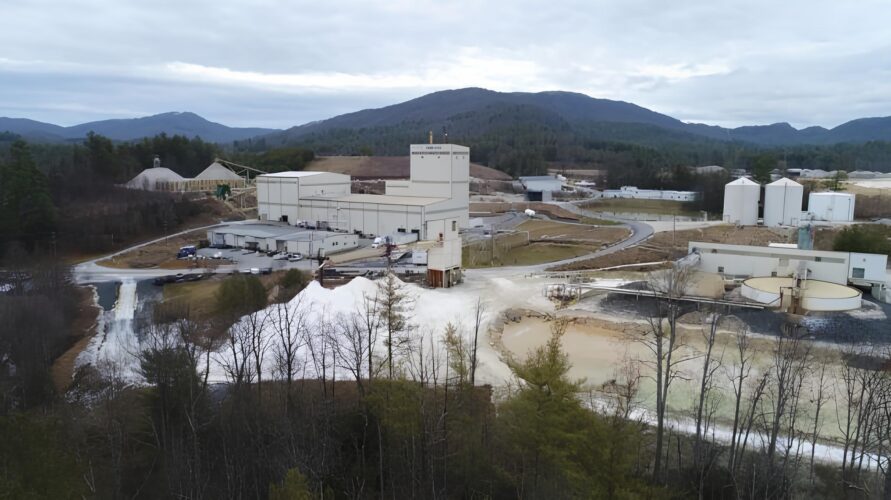In the wake of Hurricane Helene, communities across the southeastern United States have been left devastated, with washed-out roads, power outages, and catastrophic flooding complicating relief efforts. The latest counts place the death toll at nearly 200, with North Carolina alone accounting for one-third of the recorded fatalities. But as recovery operations continue in the flooded cities of Asheville and Chimney Rock, another crisis is brewing in the nearby town of Spruce Pine, where the storm’s aftereffects now threaten to cripple the international semiconductor manufacturing industry.
Founded as a railroad town in 1907, Spruce Pine is nestled in the Appalachian Mountains one hour northeast of Asheville and is home to just over 2,000 people. The town is known locally as a destination for hikers; internationally, it is known for being home to the world’s biggest—and America’s only—source of high-purity quartz (HPQ).
Given its ability to both withstand exceptionally high heat and be kept clean down to the molecular level, HPQ is used to make crucibles in which molten silicon can be refined into semiconductor wafers. The quartz is also used to create other circuit board components, as well as solar panel glass and fiber-optic cables.
Learn more about the all-new VT News and subscribe today!
While less-pure quartz mined from other sources can be used for the same purposes, the impurities make the process slower and more expensive. Outside of Spruce Pine, the next-largest HPQ deposits are found in India and Brazil, though in far smaller quantities. As a result, Spruce Pine supplies around 70% of the world’s naturally occurring HPQ, placing the town securely at the center of a $500 billion microchip industry that supports the $3 trillion global tech sector.
But in the aftermath of Hurricane Helene, this industry may be in jeopardy.
During the storm, Spruce Pine saw more than two feet of rainfall, which destroyed roads, flooded homes and businesses, and crippled public utilities. Flood waters have largely receded in the area, but the damage left behind has been extensive.
In anticipation of the destruction, Sibelco and Quartz Corp, the two largest mining operations in Spruce Pine, closed down their facilities on September 26, when Hurricane Helene made landfall in Florida. No date was given for when operations might resume.
In statements made on their respective websites, the two companies emphasized that reopening their facilities are a secondary concern given the scope of the devastation.
Many people in the area, including our employees and their families, are facing displacement and significant disruptions. We have confirmed the safety of most employees and are working diligently to contact those still unreachable due to ongoing power outages and communication challenges.”
Please rest assured that Sibelco is actively collaborating with government agencies and third-party rescue and recovery operations to mitigate the impact of this event and to resume operations as soon as possible. Our top priority remains the health, safety, and well-being of our employees, as well as ensuring the security of the Spruce Pine facility.
Our focus is to ensure that our employees and their families are safe. It is with an immense relieve that we now have been able to make contact with all employees,” said Quartz Co. “In addition to this, our teams are joining the local taskforces to try to restore the most basic services and bring further supplies to Spruce Pine.
Operations at our facilities were stopped on September 26th in preparation of the event and we have no visibility on when they will restart. This is second order of priority. Our top priority remains the health and safety of our employees and their families.
It is unclear whether the facilities or the quartz mines sustained direct damage, but local surveys indicate that the roadways to access sites have been impacted by a partial washout. While experts are indicating that a “doomsday scenario” bringing all semiconductor manufacturing to a standstill is unlikely, the bottleneck in Spruce Pine is expected to have a noticeable effect on the tech industry.
“It is rare, unheard of almost, for a single site to control the global supply of a crucial material,” economist and author Ed Conway said. “Yet if you want to get high-purity quartz—the kind you need to make those crucibles without which you can’t make silicon wafers—it has to come from Spruce Pine.”
In 2008, a fire at a Spruce Pine quartz mine “all but shut off the supply of high-purity quartz to the world market, sending shivers through the industry”—and demand for HPQ has only increased since then.
Conway, whose book Material World: The Six Raw Materials That Shape Modern Civilization explores the town’s critical role in global industry, believes that chipmakers have enough HPQ stored up to overcome a short-term disruption. However, as he indicated to Business Insider, long delays could affect production and drive up prices of high-end electronics.
“If we don’t have access to those mine for a long period of time, then the global supply of these silicon wafers is under threat,” he said.
 Connor Walcott is the lead writer for Valuetainment.com. Follow Connor on X and look for him on VT’s “The Unusual Suspects.”
Connor Walcott is the lead writer for Valuetainment.com. Follow Connor on X and look for him on VT’s “The Unusual Suspects.”
Got a hot scoop or an idea for a story? Connect with the VT writers on Minnect!


















Add comment